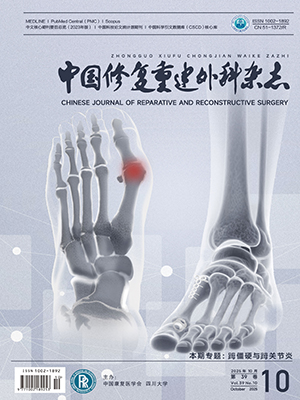| 1. |
Chipeio ML, Sayah A, Hunter CJ. Spinal tuberculosis. Am J Trop Med Hyg, 2021, 104(5): 1605-1606.
|
| 2. |
Pintor IA, Pereira F, Cavadas S, et al. Pott’s disease (tuberculous spondylitis). Int J Mycobacteriol, 2022, 11(1): 113-115.
|
| 3. |
Ali A, Musbahi O, White VLC, et al. Spinal tuberculosis: A literature review. JBJS Rev, 2019, 7(1): e9. doi: 10.2106/JBJS.RVW.18.00035.
|
| 4. |
Ru N, Wang R, Liang J, et al. Decompression and reconstruction the spinal TB lesion of a single vertebra through thoracoscopy alone or combined with foraminal endoscopy. J Orthop Surg Res, 2024, 19(1): 748. doi: 10.1186/s13018-024-05242-5.
|
| 5. |
Zhang T, Li S, Ma L, et al. Clinical effect of posterior-only approach debridement, intervertebral fusion, and internal fixation for upper thoracic tuberculosis. Acta Orthop Traumatol Turc, 2024, 58(4): 203-208.
|
| 6. |
Upadhyaya GK, Sami A, Patralekh MK, et al. Surgical management of paediatric thoracolumbar tuberculosis by a combination of anterior and posterior versus posterior only approach: A systematic review and meta-analysis. Global Spine J, 2023, 13(1): 188-196.
|
| 7. |
Qi L, Zhao Y, Xu B, et al. Two-stage treatment for severe spinal kyphotic deformity secondary to tuberculosis: halo-pelvic traction followed by a posterior-only approach correction. BMC Musculoskelet Disord, 2022, 23(1): 991. doi: 10.1186/s12891-022-05974-7.
|
| 8. |
Zhong Y, Yang K, Ye Y, et al. Single posterior approach versus combined anterior and posterior approach in the treatment of spinal tuberculosis: A meta-analysis. World Neurosurg, 2021, 147: 115-124.
|
| 9. |
Kim CW, Perry A, Garfin SR. Spinal instability: the orthopedic approach. Semin Musculoskelet Radiol, 2005, 9(1): 77-87.
|
| 10. |
Xu Z, Wang X, Zhang Z, et al. A comparison of three bone graft struts for interbody fusion using a posterior approach for lower lumbar spinal tuberculosis in adults: a midterm follow-up study. BMC Musculoskelet Disord, 2022, 23(1): 590. doi: 10.1186/s12891-022-05539-8.
|
| 11. |
Wang B, Hua W, Ke W, et al. The efficacy of allograft bone using titanium mesh in the posterior-only surgical treatment of thoracic and thoracolumbar spinal tuberculosis. BMC Surg, 2020, 20(1): 133. doi: 10.1186/s12893-020-00793-w.
|
| 12. |
Yang S, Lu H, Luo F, et al. The analysis of safety and effectiveness using allograft in the treatment of spinal tuberculosis-a multicenter retrospective study. Turk Neurosurg, 2020, 30(4): 557-564.
|
| 13. |
Hakim AR, Hidayat AR. Challenges and outcomes of upper cervical spinal tuberculosis surgery in pandemic-Case series study. Int J Surg Case Rep, 2024, 120: 109858. doi: 10.1016/j.ijscr.2024.109858.
|
| 14. |
Zhong Y, Tang B, Zhang Z, et al. Clinical efficacy and imaging analysis for the surgical treatment of thoracolumbar infections in elderly patients: a retrospective study. Sci Rep, 2023, 13(1): 10341. doi: 10.1038/s41598-023-36985-6.
|
| 15. |
Assaghir YM, Refae HH, Alam-Eddin M. Anterior versus posterior debridement fusion for single-level dorsal tuberculosis: the role of graft-type and level of fixation on determining the outcome. Eur Spine J, 2016, 25(12): 3884-3893.
|
| 16. |
Griffoni C, Tedesco G, Canella V, et al. Ceramic bone graft substitute (Mg-HA) in spinal fusion: A prospective pilot study. Front Bioeng Biotechnol, 2022, 10: 1050495. doi: 10.3389/fbioe.2022.1050495.
|
| 17. |
Li J, Qin X, Wang J, et al. Comparison of clinical efficacy and surgical safety among three bone graft modalities in spinal tuberculosis: a network meta-analysis. J Orthop Surg Res, 2023, 18(1): 368. doi: 10.1186/s13018-023-03848-9.
|
| 18. |
Pawelke J, Vinayahalingam V, Heiss C, et al. Comparison of nanocrystalline hydroxyapatite bone graft with empty defects in long bone fractures: A retrospective case-control study. Med Sci Monit, 2023, 29: e941112. doi: 10.12659/MSM.941112.
|
| 19. |
Bridwell KH, Lenke LG, Mcenery KW, et al. Anterior fresh frozen structural allografts in the thoracic and lumbar spine. Do they work if combined with posterior fusion and instrumentation in adult patients with kyphosis or anterior column defects? Spine (Phila Pa 1976), 1995, 20(12): 1410-1418.
|




